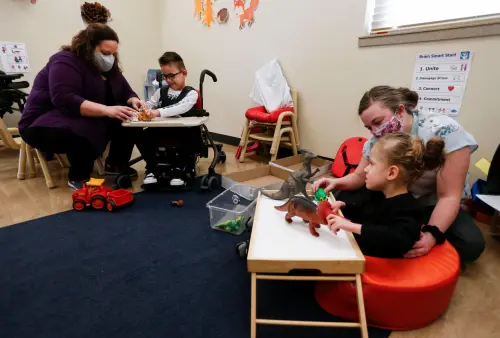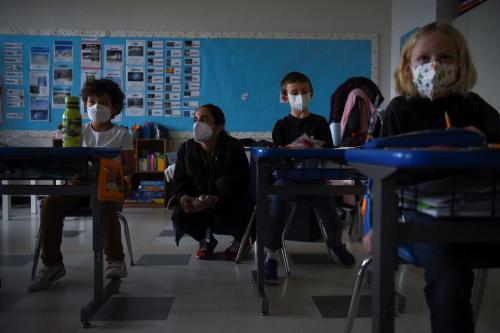The COVID-19 pandemic sounded alarms about the precarity of the teacher workforce as teachers reported high levels of burnout, stress, job dissatisfaction, and intent to leave teaching.
In early 2022, a survey from the National Education Association showed that 55% of teachers were thinking about leaving teaching “sooner rather than planned,” further stoking existing fears of an impending teacher shortage. While this high level of attrition did not materialize immediately, research using statewide administrative data has shown teacher turnover climbed in 2021 and 2022 in several states, raising concerns that the worst could be yet to come.
Concerns are amplified in high-poverty schools and districts because they face considerable challenges recruiting and retaining teachers, experience some of the most detrimental effects of teacher turnover, and grappled with especially challenging conditions during the pandemic.
Though the state data above, combined with national data on teacher shortages, paint a troubling picture about the future of the teacher workforce, the extent of the pandemic’s effects on turnover at the school level and attrition from teaching altogether remains unknown. A related open question is how district and school leaders wanting to retain the teachers in the building can do so—especially in schools and districts with the greatest staffing needs.
Our recent research speaks to both of these questions. Drawing on statewide administrative data from Michigan linked with unique teacher survey data on teacher intentions to leave and perceptions of school organizational conditions, our research examines (a) the extent to which teacher plans to leave are predictive of actually doing so, and (b) the factors that contribute to teachers’ intended and eventual turnover behavior.
Relationship between teacher intentions and behavior
Using descriptive analyses with four years of teacher survey data merged with statewide administrative data, we find that intention to leave is a significant predictor of actually doing so. About 30% of teachers who reported plans to leave their school did so the next year, consistent with prior work drawing on national survey data.
But we also find that turnover behavior often lags behind turnover intention. Figure 1 below compares the differences in teacher turnover rates between those who say they plan to leave compared with those who say they plan to stay. Each bar cluster corresponds to teachers’ stated intentions in a survey taken one, two, or three years prior to the observation of actual behavior, and the length of the bars represents the percentage of actual turnover behavior. Figure 1 shows that those who state an intention to leave do, indeed, turn over at higher rates than those who do not indicate plans to stay. Further, the figure shows that nearly two-thirds of teachers who stated an intention to leave their school (either to transfer, leave education, or retire) did so within three years.
Though not shown in the figure, there were some differences between those intending to transfer and those intending to leave teaching. Of the teachers in our sample reporting plans to transfer, more than 40% had transferred to another teaching role within three years, while 14% shifted to a non-classroom teacher role in education and three percent left or retired. Of the teachers reporting plans to leave education or retire, only 18% had actually done so by year three, but another 54% either shifted to a non-classroom-teacher role in public education or transferred to a teaching role in another school. In other words, though a teacher’s stated intent to leave or retire does not always augur a departure from the profession, it typically precedes a departure from the school.
The relationship between intent and behavior holds even after controlling for school covariates, teacher covariates, and school fixed effects—demonstrating that asking teachers about their plans can provide useful information about their eventual behavior over and above variables found in administrative datasets.
Why does it take time for some teachers to leave after they express plans to do so? To transfer schools or to take a non-teaching position within public education, teachers must not only want to leave, but there must be other positions available. Depending on teachers’ qualifications, it may take time for those who wish to transfer or leave education to find an opportunity to do so, which may explain why intent to leave is more predictive over multiple years.
This would also explain another observation we made in our analysis: teachers in hard-to-staff areas such as STEM and special education reporting plans to transfer were more likely to do so than their peers teaching subjects with fewer job openings. Our fully specified regression models controlling for teacher and school characteristics show that intent to transfer is most predictive for STEM teachers; it is associated with a 27.5-percentage point increase in actually leaving the school the following year, compared against a 22-percentage point increase for special education teachers, and a 16-percentage point increase for other teachers in models.
School factors related to intended and actual turnover behavior
For school and district leaders to reduce teacher turnover, they need to know what factors may drive teachers to leave. Existing research highlights that fixed school characteristics including concentrated poverty and racial segregation, as well as structural features like pay and benefits, require large-scale policy change that needs to happen outside the purview of the school administrators tasked with retaining teachers. But to the extent that factors contributing to teacher turnover are malleable, school and district leaders can implement programs and policies that target those areas in a way that might make teachers want to stay.
Consistent with a large body of research on school-level factors that contribute to teacher turnover, we find that teacher intentions and eventual turnover are not driven by student race and poverty levels but rather school organizational conditions and organizational commitment. Figure 2 shows coefficient estimates from regressions predicting turnover intent as a function of each of these factors (positive values indicate greater likelihood of turnover intent). Specifically, we find that positive school climate, effective school leadership, and school safety are each associated with a lower probability of intent to turn over and, to a lesser extent, actual turnover behavior. Also, buy-in to school and district improvement goals is associated with lower probability of intended and actual turnover behavior, which broadly reflects the importance of building teacher commitment to the school and its mission. This latter finding in particular has implications for schools and districts designated as low-performing and undergoing improvement interventions.
Implications for policy and practice
First, teacher-reported intentions to leave—either the school or the profession—is valuable information that should not be dismissed. Teachers who say they plan to leave their schools—either to transfer or leave education—typically do leave their school within three years. That means district leaders would benefit from surveying teachers about their plans each year and then taking those responses seriously. Our research shows that surveying teachers in the fall—when there is still time to carry out efforts to mitigate turnover—would yield valuable data rooted in teachers’ eventual behavior.
Second, there are domains of influence that school and district leaders can leverage to increase teacher job satisfaction and ultimately retention. For example, school and district leaders can take steps to improve teachers’ organizational commitment as well as school organizational conditions such as climate, leadership, and student behavior management.
Of course, improving teachers’ organizational commitment and school organizational conditions are not straightforward tasks, though there are existing interventions that show promise toward those ends. For example, strong teacher peer mentoring models, both for beginning and experienced teachers, have the capacity to strengthen organizational commitment, promote a positive school climate, foster positive peer relationships, and ultimately improve teacher retention. Streamlining and reducing teacher workload and non-classroom commitments (e.g., meetings, paperwork) can also improve teacher working conditions, job satisfaction, and retention.
A final implication is that data—on school climate, working conditions, and teacher satisfaction, along with teacher intent—can inform school improvement planning. At the state level, eight states include a school climate survey measure in their multidimensional school effectiveness indicator under the Every Student Succeeds Act. These states can provide targeted, accessible climate data to district and school leaders and help them target interventions based on their needs. Other states should consider collecting these data, too—if not for accountability purposes then to provide relevant and actionable data for school improvement and teacher retention.
The Brookings Institution is committed to quality, independence, and impact.
We are supported by a diverse array of funders. In line with our values and policies, each Brookings publication represents the sole views of its author(s).









